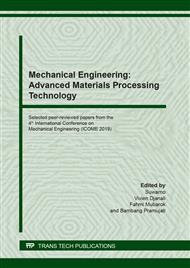p.134
p.140
p.148
p.159
p.166
p.172
p.182
p.188
p.196
Effects of Aluminum and Manganese Addition on the Microstructures and Mechanical Properties of Cu-29Zn Alloys
Abstract:
Brass with Zn content up to 35 wt.% forms the single phase of α, further the Zn content above 35 wt.% will promotes the formation of β phase. The improvement of physical and mechanical properties of brass can be conducted by addition of alloying element with optimum composition. Previous research showed that the addition of Al on brass alloy accelerated the formation of β phase and changed the microstructure and mechanical properties. Some investigation have also described that the addition of Mn on brass alloy has the good effect on tensile strength, hardness, and elongation. However, the research regarding the effect of Al and Mn addition simultaneously has not been investigated. In this research, Cu-29Zn-xAl-xMn alloys were produced by gravity die casting using pure Cu, Zn and Al ingots as well as the Mn powder as the feeding materials. Addition of Al and Mn were fixed to 0.5 and 2 wt.%, respectively. The molted metal was poured into 600 °C preheated metal mold with dimension of 100x100x6 mm3. As-cast samples were homogenized at 800 °C for 2 h in a muffle furnace. Samples characterization includes chemical composition analysis, microstructure observation, tensile and hardness testing. The results described that addition of 0.58 Al (wt.%) on Cu-29Zn alloy showed the appearance of single phase (α) and tended to increase the tensile strength but decreased the elongation. On the other hand, the addition of 0.5 Al and 1.62 Mn (wt.%) simultaneously on Cu-29Zn alloy promoted the formation of second phase (β) which dispersed in the grain and along the grain boundary with irregular forms. The addition of 0.5 Al and 1.62 Mn (wt.%) on Cu-29Zn alloy simultaneously have also increased the hardness, yield and tensile strength without decreased the elongation significantly.
Info:
Periodical:
Pages:
166-171
Citation:
Online since:
October 2020
Authors:
Keywords:
Price:
Сopyright:
© 2020 Trans Tech Publications Ltd. All Rights Reserved
Share:
Citation:


